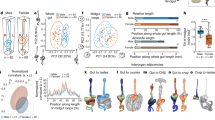Abstract
THE research which is summarized below was based on the well-known investigations of Witschi, who showed that at an early stage of development the amphibian gonad consists of a cortex and medulla. At a later stage, sex differentiation is marked by an increase of cortex relative to medulla or vice versa. If the former occurs, the undifferentiated germ cells remain in the cortex and become oocytes ; if the latter they tend to migrate into the medulla and become male gametes. Under normal conditions, the relative development of cortex and medulla is determined by the hereditary constitution, that is, by the balance between female- and male-determining genes born on the sex chromosomes and autosomes respectively, from interaction of which one or other of the primary sex 'realizers' is produced. A secondary sex determiner is then secreted by the cortex (cortexin), which initiates oogenesis and simultaneous regression of the medulla, or by the medulla (medullarin), which promotes spermato-genesis and inhibits further development of the cortex. Cortexin and medullarin must be considered as substances distinct from the adult sex hormones1.
This is a preview of subscription content, access via your institution
Access options
Subscribe to this journal
Receive 51 print issues and online access
$199.00 per year
only $3.90 per issue
Buy this article
- Purchase on Springer Link
- Instant access to full article PDF
Prices may be subject to local taxes which are calculated during checkout
Similar content being viewed by others
References
Witschi, E., "Handb. der Vererb", 2 (1929). Witschi, E. (in Allen's "Sex and Internal Secretions") (Baltimore; 1934). Witschi, E., Scientia, 68, 146 (1940).
Vannini, E., Mem. R. Accad. d'Italia, 13, 731 (1942). Vannini, E., and Busetto, I., Atti R. Ist. Veneto Sci. Lett., 104 (1945).
Vannini, E., Atti R. Ist. Veneto Sci. Lett, 104, 55 (1945).
Vannini, E., Atti R. Ist. Veneto Sci. Lett., 102, 7 (1943).
Vannini, E., Arch. Zool. Ital., 30, 363 (1942).
Galgano, M., Arch. Ital. Anat. Embry., 37, 1 (1936).
Padoa, E., Pub. Staz. Zool. Napoli, 19, 185 (1943).
Vannini, E., Atti R. Ist. Veneto Sci. Lett., 103, 535 (1944).
Vannini, E., Mem. R. Accad. d'ltalia, 14, 493 (1943).
Author information
Authors and Affiliations
Rights and permissions
About this article
Cite this article
VANNINI, E. SEX DIFFERENTIATION IN AMPHIBIA. Nature 157, 812–813 (1946). https://doi.org/10.1038/157812a0
Issue Date:
DOI: https://doi.org/10.1038/157812a0
This article is cited by
Comments
By submitting a comment you agree to abide by our Terms and Community Guidelines. If you find something abusive or that does not comply with our terms or guidelines please flag it as inappropriate.



